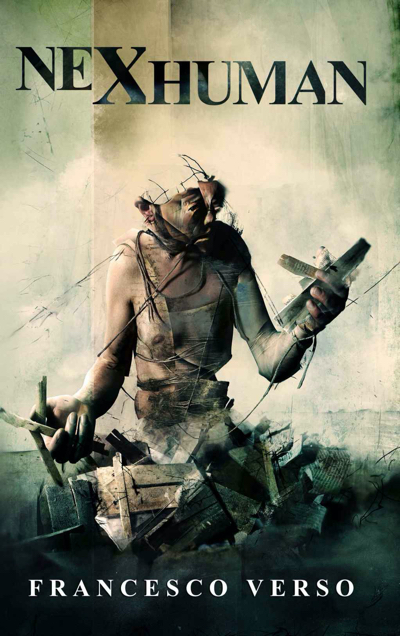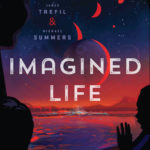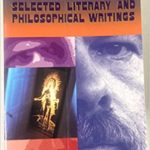Nexhuman by Francesco Verso brilliantly blends the story of a young man’s obsessive love for a transhuman being with a vivid depiction of a consumerist society strangling on its own trash. Skillfully translated by Sally McCorry, the novel poses powerful questions about what it means to be human.

We see this world through the eyes of Peter Payne, a fifteen year-old learning the trade of salvaging trash, or kipple (a term borrowed from Philip K. Dick). Relentlessly shamed and manipulated by a bullying older brother, Peter immerses himself in fantasies. When he’s not learning his hardscrabble trade in kipple, he spends his time in the virtual “gamesphere” pursuing adventures around the world. But all that changes when he finds someone to love.
Transhuman as Other
That is Alba, a beautiful woman in her twenties who runs a travel agency near the trash hill where he works. He follows her every move with his binoculars and arranges to “casually” meet her to say hello on the street. In his fifteen year-old soul, that is enough to inflame a love for her that will guide the rest of his life.
The hateful brother Charlie and his gang of thugs called the Dead Bones set upon Alba one night and tear her limb from limb. Turns out she is a nexhuman, a human personality downloaded to a perfect but artificial body.
Charlie and his ilk fear and hate this new form of “other” and the law doesn’t recognize destruction of nexhumans as murder. But Peter, who himself was once torn apart by a salvaging machine and now has an artificial arm and leg, is completely traumatized. He quickly retrieves Alba’s head and vows to find the rest of her body and reassemble the parts. That quest, yet another variant on the theme of Frankenstein, becomes the meaning and goal of his existence, and, of course, the prime mover of the story.
Love or Illusion?
Peter idealizes Alba, as a 15 year old might, with romantic intensity based on only casual contact. Real knowledge of the person behind the body and superficial personality isn’t needed to feed his obsession and love for her perfection.
It is only after his derelict genius friend Ion takes him to the transhumanist Temple that he finds out where her mind is stored and has a chance to meet Alba as she was in her first life.
Prior to that, he wonders about the possibility of other Albas downloaded to different bodies, versions of her who never had those casual meetings with a teenager named Peter. But that hardly matters to the boy who becomes a man in the course of the story. He needs only the empty shell of her body to be satisfied in some mysterious way.
Peter is interesting because he is well aware that he is pursuing an illusion and often reflects on the strangeness of his quest. But that does not stop him from enduring all sorts of grim experiences in hideous nooks of an already trash-choked city to find the lost body parts of his nexhuman love.
When it comes to the climactic struggle between the brothers (“two idiots fighting a senseless duel”), Peter says: “We both insist on the rectitude of our respective illusions. Mine is love, Charlie’s is power. What is the point of all this?”
The City of Kipple
Despite his idealistic quest to reassemble Alba, Peter lives in the gritty present of a city drowning in kipple. His job for the company called Reverse is to find trash of value and, if not bring it back to life, at least enhance its value.
Reverse calls this trashforming, but Peter prefers to think of himself as a salvager of materials. Sometimes he barters or sells his salvaged pieces on the side. Much of the city’s population, including Peter’s family, not only make their living through trash but also live in repurposed tumble-down buildings bordering the kipple mounds.
Through the class-stratified megalopolis flow rivers that gather old computer monitors, shells of PCs, and circuit boards, mimicking Peter’s gathering of the remains of the consumerist society. “Everything ends up as kipple,” Peter observes. While the trade in restored trash seems to keep the city going, most of it is saturated with decay.
My eyes range over the view: crumbling ruins, cancerous structures bearing the marks of soot and rubbish, a land where even colour comes to die.
Nexhuman p18 (Kindle edition)
Transhumanism
As Peter gets closer to achieving his goal of reassembling Alba’s body, he has to confront the possibility that, once a new download to her physical form is complete, she may have no memory of him. She may be a much different person. As his friend Ion warns:
If you meet Alba now, it won’t be the Alba you knew in the past. The idea is like that of flowing water; she won’t be the same because what she consists of has changed.
Nexhuman p156 (Kindle edition)
An avatar of the transhumanist Temple, where all the uploaded minds seem to dwell, explains that every time a stored consciousness enters a new body, they embark on a new life. The only connection to other physical versions of that self is the past memory of their first existence. Their futures diverge and do not share experience.
As he thinks about his own life, he wonders if he too might need more than one lifetime to find out who he truly is. Why be captive to a single body? Reflecting on the popular demand to extend life by replacing body parts, he asks: “Who wants to be stuck in the chrysalis when you can be free to fly like a butterfly?”
Longing for Fulfillment
While Nexhuman poses many questions about transhumanism, the hope for immortality and the place of minds downloaded to new bodies in society, this is a novel, not an essay. It is primarily about longing for love and fulfillment. That is why this is Peter’s story, not Alba’s.
Peter is suspended between hatred for his poor record as a person, perpetual victim of a monstrous brother, and the lure of the perfection of love and destiny that fantasy and dreams of fulfillment can offer. The grotesque efforts to find and reassemble Alba’s body parts dramatize the desperation of his hope.
Francesco Verso concludes this fascinating novel with multiple endings, as if to emphasize that Peter’s dreams require multiple versions of reality and, perhaps, of Peter himself to reach fulfillment. Nexhuman is a masterful story of longing, the limits of human life and a possible future for exceeding those limits.




Leave a Reply